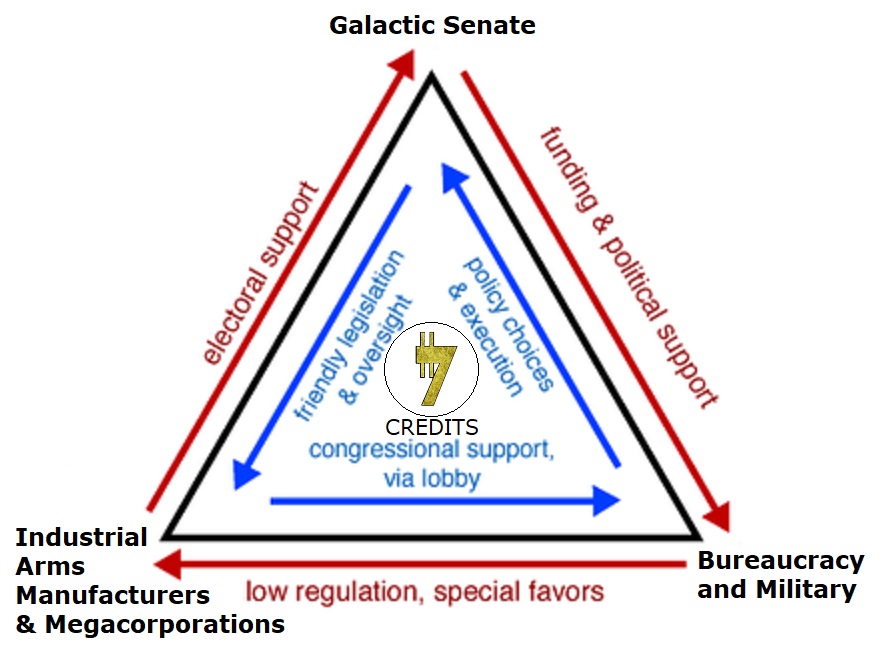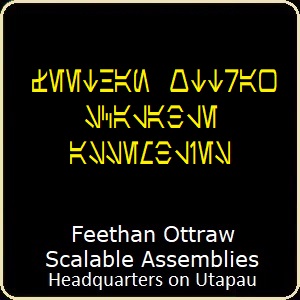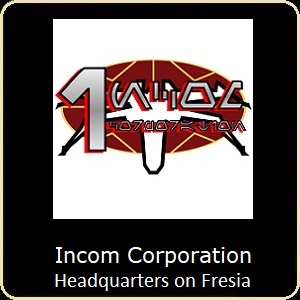

Commerce Guild | IG Banking Clan | Techno Union | Trade Federation
Corporate Alliance | Other Concerns | Other Tech

"In the councils of government, we must guard against the acquisition of unwarranted influence, whether sought or unsought,
by the military-industrial complex. The potential for the disastrous rise of misplaced power exists and will persist."
"This conjunction of an immense military establishment and large arms industry is new in the American experience.
The total influence - economic, political, even spiritual - is felt in every city, every Statehouse, every Federal government.
We recognize the imperative need for this development. Yet we must not fail to comprehend its grave implications.
Our toil, resources, and livelihood are all involved; so is the very structure of our society."
Those quotations from U.S. President Eisenhower's 1961 farewell address were meant to illustrate the threat posed to a society's democratic nature by
weapons manufacturers and the financial institutions connected to them. Weapons manufacturing is a very lucrative industry, and with great wealth
comes great influence. Military industries, and indeed any company which contracts with a government, has a vested interest in increasing public
spending on their products and services. Since these companies exist to make money, and are invested in by those who wish to make big money,
it is in their interest to increase political strife, encourage warmongering, and to foment actual wars and conflicts. In a democracy, leaders who are
corrupt but good at acting to the public often win office, and are more than happy to lobby on behalf of corporate interests to become personally
wealthy. This creates a cycle whose momentum becomes harder and harder to stop, with the predictable results: an increase in hostile foreign policy
and saber-rattling, media narratives and political campaigns designed to manufacture consent, and huge amounts of public money funneled into
industries designed to fight wars. This is not a feature unique to the post-WW2 United States, in fact this relationship between war material producers
and the authorities has existed in one form or another in most societies since the ancient invention of the city-state. Nevertheless, a democracy with
a huge population like the United States is ruled over by a relatively small percentage of its citizens. Combined with fact that the expense of modern
high-technology weapons compared to making swords or bows and arrows makes weapons sales profitable on a scale unmatched in history, there
was little to stop the complete transformation of society in the United States around serving the interests of arms dealers and the banks and large
conglomerates which own them or invest in them. This is a prime example of something that happened throughout history, and will unfortunately
probably continue into our future. The MIC triangle can ultimately collapse its society, something George Lucas was trying to illustrate in SW.

By the time George Lucas was developing SW in the mid-70s, the result of the growth of the MIC's power was obvious, as the United States'
involvement in the Vietnam War was a direct result of all three corners of the triangle pushing for more involvement and more war. Despite
Eisenhower's warning, the United States and its society had become more militaristic, and was devoting an ever-increasing portion of its national
budget to so-called 'defense' spending. A major theme of Lucas' SW trilogy was the MIC, most directly referenced by the Empire. Like many
empires in history, the Empire believes that superior numbers and firepower will ultimately win, that superior technology means the enemy has
no chance, and that superweapons of insane destructive power will render them invincible and prevent any possible stand against them.
This superweapon hunt was a definite reference to the actions of empires like the United States, Nazi Germany, and the Soviet Union, willing to
pour huge fortunes and labor into producing ultimate weapons, massive continent-wide defense structures, and always bigger, more powerful
machines. The Imperial attitude towards the Rebels was referencing nearly every empire in history, but was also meant as a specific commentary
on the arrogance of the United States believing that it could defeat the Vietnamese in their own country by having a massively superior military
and a major technological advantage. The United States bombed nearly every corner of Vietnam, Laos, and Cambodia, dropping 7.5 million tons
of bombs during the war, twice the amount of all the bombs dropped in WW2, but was unable to stop the desire of the Vietnamese to be free
from foreign occupation, ultimately resulting in the United States' defeat. What the United States did was a crime, which it did because like
the Empire, its leaders believed in order through strength and violence, and in the money and influence which weapons developers could bring them
personally. As if the violence perpetrated weren't bad enough, the additional crime is of course that huge sums of public money went to already wealthy
corporations rather than spent within the country to make life better for its people. The social order becomes conditioned to serve the needs of the MIC.

The Empire is also a fascist economy, which is one in which the weapons manufacturers, megacorporations, and major industries are openly
running the government, or are openly run by the government, through unified, ideological parties which rule without restriction. This type of
government is fueled by conflict and war, and no longer has to be coy about its desire to attack things it doesn't control and to beat opposition
into submission. Fascism takes advantage of the democratic system to take over and then eliminate those who disagree with them from the political
process, and thus a runaway MIC not only threatens other countries and transforms a society's purpose, it can also easily result in bringing fascism
to power, as it did in the 1930s. By the time George Lucas was working on producing the prequels, the MIC in the United States had grown even
more entrenched and powerful, despite the Cold War's end and the lack of meaningful threat to justify continuing massive spending. The prequel
films show in great detail how this process works in a democracy, illustrating how corporations start wars for their own greed, how private agendas
of corrupt officials can use that predictable greed to manipulate an elected body, and ultimately how fascism comes to power painted as patriotic
nationalism promising peace through the security of the gun. Despite the popularity of the SW films in the United States, it doesn't seem like most fans
understood Lucas' message, or if they did must have been rooting for the Empire and Palpatine when they watched. Since the last of the six SW films
was released, the power of the MIC in the United States has only increased, and its ability to manipulate the majority of the population through media
and politicians has continued and has even been streamlined. Those who fail to learn from history are doomed to repeat it, something that unfortunately
seems inevitable most of the time. The two SW trilogies aimed to make these lessons available to a wider audience than those who read history.
REPUBLIC ERA
The military-industrial complex in the prequels and other Republic-era material combines elements of MICs from several periods in history, most
particularly the political structure of late 20th century in the United States, the partially post-feudal institutions of the Industrial Revolution eras
around the world, and the state-affiliated trade companies of the European empires during the Age of Exploration. Several elements of the Republic's
socio-economy are also based on ancient Rome, which itself was styled a republic, and only later embraced the reality that it was an empire.
The transformation of society through a war engineered by ideological politicians and greedy economic interests is a reference to nearly every
war in modern Earth history, and indeed most wars on this planet over the last several thousand years. The clones, who are essentially organic
battle droids, are not only a chilling vision of disposable people but also a representation of how living beings are part of the machinery of the MIC.
The machine designs and trains people to suit its purposes, and then uses and discards them, intending to be paid again to do this to more people.

The later days of the Galactic Republic were dominated large and powerful galactic trade guilds, some of which controlled a seat in the Senate
directly. In addition, a massive association of corporations known as the Corporate Alliance magnified the collective political and legal authority
of private interests in the galaxy. These guilds mostly evolved naturally in the golden era of expansion and trade during the last thousand years
of the Republic's reign. These organizations, as well as many other interstellar interests, were more powerful than any single planet, and had
massive operations which needed safeguarding. As a result, trade guilds operated huge private security armies, and usually owned military
equipment producing corporations within their conglomerates. The guilds owned thousands of planets and had their own private domains,
principally in remote regions of the Rim. As a result the guilds competed with each other in territorial squabbles and arms races, all of which
fueled their profitable arms manufacturing. Their power grew to such an extent that they could effectively resist most efforts in the Senate
to oppose their policies, leading to an era of massive corruption, political deadlock, and lax enforcement of regulations on the private sector.
The guilds ultimately grew arrogant and brazen with their ability to manipulate the Senate, and working with ideologically driven forces helped
to provoke and plan the Clone Wars as part of a scheme to make unimaginable new profits, and potentially gain even more direct authority over
the galaxy than they already had. Fear, anger, and other emotions generated by the war led the majority of those loyal to the Republic to actively
embrace the policies of militarization without examining the role those who would profit from the war had in creating the war in the first place.
Republic armies, facilities, and ships built for the Clone Wars were among the largest and most expensive ever constructed in the galaxy, and
began a society-wide program of armament and militarization which would only increase over the coming decades.


IMPERIAL ERA
The military-industrial complex in the original trilogy and other Imperial-era material also combines elements of many MICs, but is most directly
modeled after Nazi Germany and the other fascist governments of the 1930s and 40s. Its obvious evil, and the many parallels between the Empire
and the actions and attitudes of nations during the Cold War including the Soviet Union, France, the United Kingdom, China, India, and foremost
the United States, were intentional allusions. The quest for doomsday superweapons and massive military machines, along with the suppression
of rebellion, social upheaval, and independent places, are the predictable results of the runaway militarization of society and the silencing of
voices calling for peaceful industry and an end to the security state. The transformation of society which began through the Clone Wars, in
this instance essentially their version of WW2, is realized to its greatest extent, as every aspect of society is now interconnected and geared
towards funding, building, staffing, and backing the Imperial military. Militarism and state violence have become normalized in public life.

The Galactic Empire's economy was dominated by large interests and corporations which were either state owned or state affiliated.
While the trade guilds were all ruined by the Clone Wars, many of their larger components survived and integrated one way or another into
the Imperial economic structure. Most of the major arms manufacturers earned their position of prominence by being well-connected to
the Imperial inner circles. Some of the galaxy's more ancient institutions like the Banking Clan and the Mining Guild were indispensable,
and were more or less nationalized under the Empire. The Corporate Alliance's influence and usefulness to the Empire was so great that
it survived the Clone Wars, and still maintained a measure of independent authority under the Corporate Sector Authority, established to
allow a low-regulation environment in the Corporate Sector. Most major industry connected in any way to the military was nationalized
early in the Imperial era, except for those companies whose leaders were in favor with the Emperor and his court. The Empire engaged
in a slow but steady nationalization program designed to incrementally absorb all economic activity of any consequence, which if
carried out to its conclusion would have eventually left everyone in the galaxy working directly for the state, a full realization of fascism.
Outside of the context of fascism, the MIC in the Empire developed the same cycle as the MIC in a corporate democracy: war is good for
industry, industry is good for jobs which people need, therefore many people support conflict because it supports industry and their job.
If there was a peace economy instead of a war economy, industry and jobs would exist without the war, but once the war industry cycle has
taken over, workers must participate in it to make ends meet, which in turn creates generational loyalty to the war machine in some workers.

As an empire, as well as a fascist state, the Galactic Empire celebrates militarism, and thus is enthusiastic about devoting huge resources to
building absurdly large military equipment, and has enough patriotic supporters to staff their gargantuan military. The Empire's strategy
focuses on building ships and assault craft too large and powerful to destroy easily, pressing its advantage in resources and monopoly on
open construction of large-scale warships. As the years pass, even though the Empire's potential opponents grow less and less capable of
threatening the Empire's massive fleet of huge warships, the war machine continues to construct even larger and more expensive craft.


The Death Star is the ultimate metaphor for a militarized society, as it is an artificial world built on the labor and resources of natural planets
and their people, with the sole purpose of destroying anything that opposes it. This artificial planet will be more powerful than all the other
planets, and the millions of people who work on and inhabit the machine will live a life of service to war in a world devoted entirely to war.
The machine is only good for conflict and destruction, therefore will always be searching for reasons to do what it was meant to do.
The machine will require constant upkeep and endless lifetimes of labor to maintain it, but it will have achieved its only goals: to be
practically undefeatable, to be able to obliterate entire opponents at will, and to have as much of society devoted to it as possible.
It is a world entirely devoted to militarism and the production of war material, where society and the MIC are one.

NEW REPUBLIC ERA
The military-industrial complex in the post Imperial-era material is largely unexplored thus far, however we do know that Lucas had
intended this period to be similar to post-WW2 Europe in terms of economy and infrastructure. While some of it is intact, much of
it is severely damaged or totally destroyed. Imperial rule, war, starvation, and unrest has notably reduced the over all galactic population,
however the degree to which that has happened on any given planet varies greatly. A great deal of the traditional trade structures from
the Republic and Imperial eras have been damaged, many irreparably, and there is a lack of strong centralized government in the galaxy
and widespread disagreement about the actual value of credits. This means that large corporations, even those which became important
during the Civil War, must deal with a depressed and uncertain market, difficult supply chains, and lawlessness. This also means there is
a great deal of opportunity for companies which survived the war, and little standing in their way in terms of expanding their operations.
If crime syndicates turned into petty states are any indication, megacorporations are filling vacuums of power with their own authority.
If the New Republic succeeds in restoring some measure of unity, it will need the support of such entities, once again restoring the place
of the MIC and the private interests of megacorporations in the galactic democracy, ultimately resulting in the same cycle beginning again.

The non-Lucas disney trilogy explored the idea that the major manufacturers would continue designing larger, more advanced, and more
formidable versions of their prior technology. This seems like a logical deduction, however since nothing of what is going on in the galaxy is
ever explored, we have no basis to determine if this would indeed be the case. The Empire was able to reach unforeseen levels of engineering
because it had basically unlimited resources and financial backing, no opponents or serious threats to divert resources away from production,
and could openly construct starships in shipyards and in planetary fabrication facilities without having to hide its activities. Based on what little
was told to us of the situation in the galaxy post-Empire, it doesn't seem like the necessary prerequisites for this construction would have been
possible. It is therefore unlikely this development occurred, although it likely would have had the Core remained stable, and had continued
to be dominated by militaristic elements. If the arms manufacturers still controlled the politics, such development would be far more likely.

MILITARY-INDUSTRIAL INTERESTS
All large industries have an effect on politics and public policy, however most of those industries can function just fine in a world without war,
violence, or insecurity. Arms manufacturers cannot, and many other corporations which produce non-military technology also produce arms,
and therefore also have a vested interest in being able to continue to sell these highly-profitable products. Not all manufacturers of military
equipment and arms are known, but these companies represent the most prominent and influential during the Republic and Imperial eras:
Known Major Arms Manufacturers















Known Major Battledroid Manufacturers





Known Major Military Hardware and Starship Manufacturers














Known Major Starfighter Manufacturers









